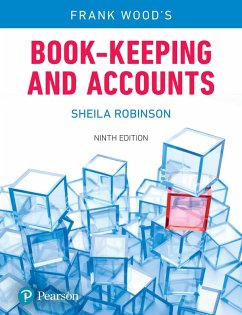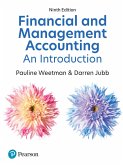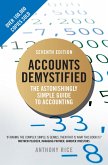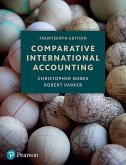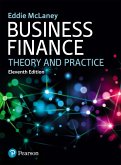42,95 €
42,95 €
inkl. MwSt.
Sofort per Download lieferbar

21 °P sammeln
42,95 €
Als Download kaufen

42,95 €
inkl. MwSt.
Sofort per Download lieferbar

21 °P sammeln
Jetzt verschenken
Alle Infos zum eBook verschenken
42,95 €
inkl. MwSt.
Sofort per Download lieferbar
Alle Infos zum eBook verschenken

21 °P sammeln
- Format: ePub
- Merkliste
- Auf die Merkliste
- Bewerten Bewerten
- Teilen
- Produkt teilen
- Produkterinnerung
- Produkterinnerung

Bitte loggen Sie sich zunächst in Ihr Kundenkonto ein oder registrieren Sie sich bei
bücher.de, um das eBook-Abo tolino select nutzen zu können.
Hier können Sie sich einloggen
Hier können Sie sich einloggen
Sie sind bereits eingeloggt. Klicken Sie auf 2. tolino select Abo, um fortzufahren.

Bitte loggen Sie sich zunächst in Ihr Kundenkonto ein oder registrieren Sie sich bei bücher.de, um das eBook-Abo tolino select nutzen zu können.
Book-keeping and Accounts
- Geräte: eReader
- ohne Kopierschutz
- eBook Hilfe
Andere Kunden interessierten sich auch für
![Financial and Management Accounting: An Introduction (eBook, ePUB) Financial and Management Accounting: An Introduction (eBook, ePUB)]() Pauline WeetmanFinancial and Management Accounting: An Introduction (eBook, ePUB)42,95 €
Pauline WeetmanFinancial and Management Accounting: An Introduction (eBook, ePUB)42,95 €![Accounting for Non-Accounting Students (eBook, ePUB) Accounting for Non-Accounting Students (eBook, ePUB)]() John R. DysonAccounting for Non-Accounting Students (eBook, ePUB)42,95 €
John R. DysonAccounting for Non-Accounting Students (eBook, ePUB)42,95 €![Accounts Demystified (eBook, ePUB) Accounts Demystified (eBook, ePUB)]() Anthony RiceAccounts Demystified (eBook, ePUB)13,95 €
Anthony RiceAccounts Demystified (eBook, ePUB)13,95 €![Comparative International Accounting (eBook, ePUB) Comparative International Accounting (eBook, ePUB)]() Christopher NobesComparative International Accounting (eBook, ePUB)42,95 €
Christopher NobesComparative International Accounting (eBook, ePUB)42,95 €![Corporate Finance: Principles and Practice (eBook, ePUB) Corporate Finance: Principles and Practice (eBook, ePUB)]() Denzil WatsonCorporate Finance: Principles and Practice (eBook, ePUB)42,95 €
Denzil WatsonCorporate Finance: Principles and Practice (eBook, ePUB)42,95 €![Business Finance (eBook, ePUB) Business Finance (eBook, ePUB)]() Eddie MclaneyBusiness Finance (eBook, ePUB)42,95 €
Eddie MclaneyBusiness Finance (eBook, ePUB)42,95 €![Frank Wood's Business Accounting, Volume 2 (eBook, ePUB) Frank Wood's Business Accounting, Volume 2 (eBook, ePUB)]() Alan SangsterFrank Wood's Business Accounting, Volume 2 (eBook, ePUB)42,95 €
Alan SangsterFrank Wood's Business Accounting, Volume 2 (eBook, ePUB)42,95 €-
-
-
Book-keeping and Accounts
Dieser Download kann aus rechtlichen Gründen nur mit Rechnungsadresse in A, B, BG, CY, CZ, D, DK, EW, E, FIN, F, GR, HR, H, IRL, I, LT, L, LR, M, NL, PL, P, R, S, SLO, SK ausgeliefert werden.
Produktdetails
- Produktdetails
- Verlag: Pearson HigherEducation
- Seitenzahl: 632
- Altersempfehlung: ab 18 Jahre
- Erscheinungstermin: 20. Dezember 2017
- Englisch
- ISBN-13: 9781292129204
- Artikelnr.: 50527270
- Verlag: Pearson HigherEducation
- Seitenzahl: 632
- Altersempfehlung: ab 18 Jahre
- Erscheinungstermin: 20. Dezember 2017
- Englisch
- ISBN-13: 9781292129204
- Artikelnr.: 50527270
- Herstellerkennzeichnung Die Herstellerinformationen sind derzeit nicht verfügbar.
PART 1 INTRODUCTION TO PRINCIPLES OF ACCOUNTING
1: Introduction to accounting principles
2: The accounting system
3: The accounting equation and statement of financial position
4: The double entry system for assets, liabilities and capital
5: The double entry system for inventory
6: The double entry system for expenses and revenues
7: Balancing off accounts
8: The trial balance
9: Capital and revenue expenditures
PART 2 THE FINANCIAL STATEMENTS OF SOLE TRADERS
10: Introduction to statements of profit or loss
11: Statements of financial position
12: Statements of profit or loss and statements of financial position:
further considerations
13: Accounting standards, rules and concepts
PART 3 BOOKS OF ORIGINAL ENTRY
14: Value added tax (VAT)
15: Business documentation
16: Division of the ledger: sales day book and sales ledger including VAT
17: Purchases day book and purchases returns day book
19: Analytical day books
20: Business banking
21: Cash books
22: Petty cash and the imprest system
23: Bank reconciliation statements
24: The journal
25: Control accounts
PART 4 ADJUSTMENTS TO FINANCIAL STATEMENTS
26: Depreciation of non-current assets
27: Double entry records for depreciation and the disposal of assets
28: Bad debts and allowances for doubtful debts
29: Accruals, prepayments and other adjustments for financial statements
30: Extended trial balance
31: Inventory valuation
32: Errors not affecting trial balance agreement
33: Suspense accounts and errors
PART 5 FINANCIAL STATEMENTS OF OTHER ORGANISATIONS
34: Single entry and incomplete reocrds
35: Accounting for non-profit-making organisations
36: Partnership accounts
37: Limited company accounts
38: Manufacturing accounts
39: Analysis and interpretation of financial statements
PART 6 ASSOCIATED ACCOUNTING TOPICS
40: Computers and accounting systems
41: Ethics: getting it right as a professional
APPENDICES A TO E
1: Introduction to accounting principles
2: The accounting system
3: The accounting equation and statement of financial position
4: The double entry system for assets, liabilities and capital
5: The double entry system for inventory
6: The double entry system for expenses and revenues
7: Balancing off accounts
8: The trial balance
9: Capital and revenue expenditures
PART 2 THE FINANCIAL STATEMENTS OF SOLE TRADERS
10: Introduction to statements of profit or loss
11: Statements of financial position
12: Statements of profit or loss and statements of financial position:
further considerations
13: Accounting standards, rules and concepts
PART 3 BOOKS OF ORIGINAL ENTRY
14: Value added tax (VAT)
15: Business documentation
16: Division of the ledger: sales day book and sales ledger including VAT
17: Purchases day book and purchases returns day book
19: Analytical day books
20: Business banking
21: Cash books
22: Petty cash and the imprest system
23: Bank reconciliation statements
24: The journal
25: Control accounts
PART 4 ADJUSTMENTS TO FINANCIAL STATEMENTS
26: Depreciation of non-current assets
27: Double entry records for depreciation and the disposal of assets
28: Bad debts and allowances for doubtful debts
29: Accruals, prepayments and other adjustments for financial statements
30: Extended trial balance
31: Inventory valuation
32: Errors not affecting trial balance agreement
33: Suspense accounts and errors
PART 5 FINANCIAL STATEMENTS OF OTHER ORGANISATIONS
34: Single entry and incomplete reocrds
35: Accounting for non-profit-making organisations
36: Partnership accounts
37: Limited company accounts
38: Manufacturing accounts
39: Analysis and interpretation of financial statements
PART 6 ASSOCIATED ACCOUNTING TOPICS
40: Computers and accounting systems
41: Ethics: getting it right as a professional
APPENDICES A TO E
PART 1 INTRODUCTION TO PRINCIPLES OF ACCOUNTING
1: Introduction to accounting principles
2: The accounting system
3: The accounting equation and statement of financial position
4: The double entry system for assets, liabilities and capital
5: The double entry system for inventory
6: The double entry system for expenses and revenues
7: Balancing off accounts
8: The trial balance
9: Capital and revenue expenditures
PART 2 THE FINANCIAL STATEMENTS OF SOLE TRADERS
10: Introduction to statements of profit or loss
11: Statements of financial position
12: Statements of profit or loss and statements of financial position:
further considerations
13: Accounting standards, rules and concepts
PART 3 BOOKS OF ORIGINAL ENTRY
14: Value added tax (VAT)
15: Business documentation
16: Division of the ledger: sales day book and sales ledger including VAT
17: Purchases day book and purchases returns day book
19: Analytical day books
20: Business banking
21: Cash books
22: Petty cash and the imprest system
23: Bank reconciliation statements
24: The journal
25: Control accounts
PART 4 ADJUSTMENTS TO FINANCIAL STATEMENTS
26: Depreciation of non-current assets
27: Double entry records for depreciation and the disposal of assets
28: Bad debts and allowances for doubtful debts
29: Accruals, prepayments and other adjustments for financial statements
30: Extended trial balance
31: Inventory valuation
32: Errors not affecting trial balance agreement
33: Suspense accounts and errors
PART 5 FINANCIAL STATEMENTS OF OTHER ORGANISATIONS
34: Single entry and incomplete reocrds
35: Accounting for non-profit-making organisations
36: Partnership accounts
37: Limited company accounts
38: Manufacturing accounts
39: Analysis and interpretation of financial statements
PART 6 ASSOCIATED ACCOUNTING TOPICS
40: Computers and accounting systems
41: Ethics: getting it right as a professional
APPENDICES A TO E
1: Introduction to accounting principles
2: The accounting system
3: The accounting equation and statement of financial position
4: The double entry system for assets, liabilities and capital
5: The double entry system for inventory
6: The double entry system for expenses and revenues
7: Balancing off accounts
8: The trial balance
9: Capital and revenue expenditures
PART 2 THE FINANCIAL STATEMENTS OF SOLE TRADERS
10: Introduction to statements of profit or loss
11: Statements of financial position
12: Statements of profit or loss and statements of financial position:
further considerations
13: Accounting standards, rules and concepts
PART 3 BOOKS OF ORIGINAL ENTRY
14: Value added tax (VAT)
15: Business documentation
16: Division of the ledger: sales day book and sales ledger including VAT
17: Purchases day book and purchases returns day book
19: Analytical day books
20: Business banking
21: Cash books
22: Petty cash and the imprest system
23: Bank reconciliation statements
24: The journal
25: Control accounts
PART 4 ADJUSTMENTS TO FINANCIAL STATEMENTS
26: Depreciation of non-current assets
27: Double entry records for depreciation and the disposal of assets
28: Bad debts and allowances for doubtful debts
29: Accruals, prepayments and other adjustments for financial statements
30: Extended trial balance
31: Inventory valuation
32: Errors not affecting trial balance agreement
33: Suspense accounts and errors
PART 5 FINANCIAL STATEMENTS OF OTHER ORGANISATIONS
34: Single entry and incomplete reocrds
35: Accounting for non-profit-making organisations
36: Partnership accounts
37: Limited company accounts
38: Manufacturing accounts
39: Analysis and interpretation of financial statements
PART 6 ASSOCIATED ACCOUNTING TOPICS
40: Computers and accounting systems
41: Ethics: getting it right as a professional
APPENDICES A TO E
